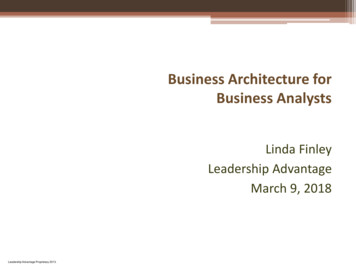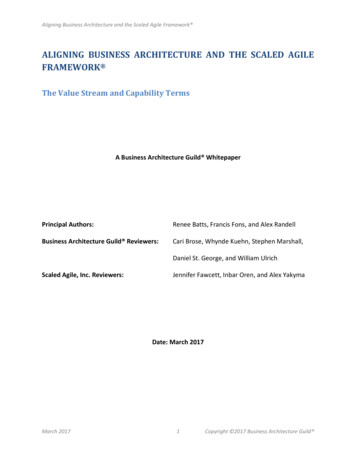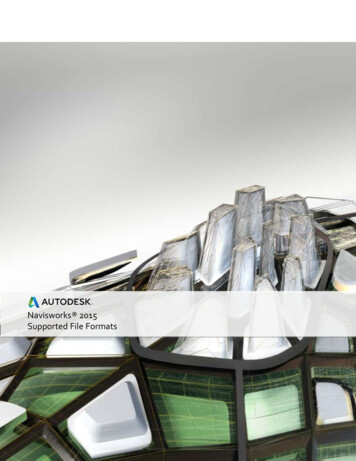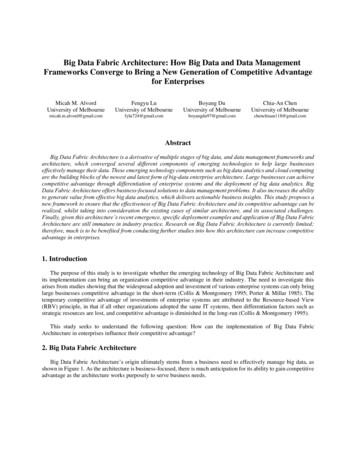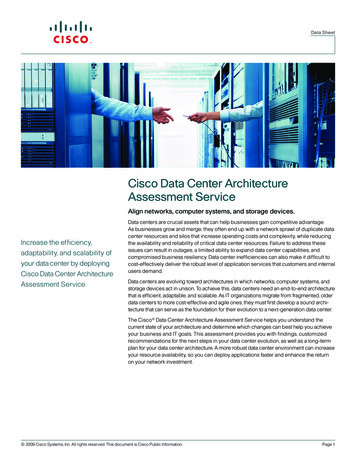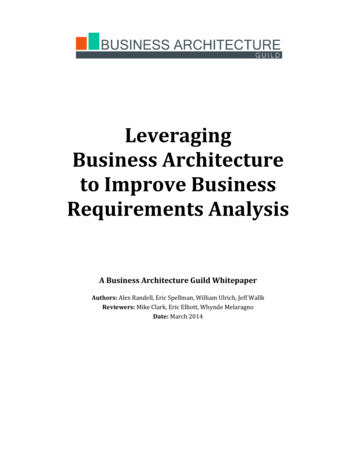
Transcription
LeveragingBusiness Architectureto Improve BusinessRequirements AnalysisA Business Architecture Guild WhitepaperAuthors: Alex Randell, Eric Spellman, William Ulrich, Jeff WallkReviewers: Mike Clark, Eric Elliott, Whynde MelaragnoDate: March 2014
Leveraging Business Architecture to Improve Business Requirements AnalysisIntroductionWith all the money and resources invested in new product development, over 80% will fail. 1That is an astonishing fact given all the information and knowledge being tracked aboutcustomers, products, competitors, and environmental factors. This level of waste would neverbe tolerated in any supply chain, yet it persists and prospers in most organizations. The numberone reason for this level of failure is the inability of organizations to link the relevancy of theirproducts to what their customer’s are trying to get done in their lives. 2“The statistics are quite alarming when it comes to new products; 4 out of 5 will fail.”The problem doesn’t stop at defining customer needs. Projects designed to deliver newproducts involving information technology also have a poor track record. There is a clear needto improve performance and delivery of software projects. Consider that 70% of softwareprojects fail due to poor requirements. The estimated rework associated with these failuresexceeds 45 billion annually. The question is – why is this happening? The answer is twofold.First, business requirements tend to lose focus on the customer; and second, the requirementslack a holistic frame of reference that enables requirements analysts to drive and tracerequirements from customer need, through strategy, and down to the solutions beingimplemented. Business architecture addresses both challenges and has the potential to turnthis figure around.“70% of software projects fail due to poor requirements with an associated reworkspend just north of 45 billion annually” 3Most organizations treat requirements management as a means towards an end for projectsand/or programs. Successful organizations tend to think about requirements management as acorporate capability and the data that is captured as a corporate asset, which can be carefullynurtured, validated, warehoused, and mined. Done right, requirements management can beused to link desired outcomes from customers and stakeholders to drive change and ensuresustainability for the organization. As the complexity of launching new products and servicesand driving continuous improvement increases, organizations are turning to businessarchitecture to help them reduce risk, costs, and cycle time.A Guide to the Business Architecture Body of Knowledge (BIZBOK Guide) 4 has helpednumerous organizations establish a business architecture framework that can be leveragedthroughout the requirements management lifecycle. The next evolution for the requirementsmanagement lifecycle is to fully incorporate this framework to maintain a customerperspective, aligned to strategies, value streams, business capabilities, and planning roadmaps.March 20142Copyright 2014 Business Architecture Guild
Leveraging Business Architecture to Improve Business Requirements AnalysisThe outcome of this alignment is an improvement in the success ratio of product-relatedinvestments.Ideally, organizations should commit to an institutionalized priority around customer focus. Thisrequires a level of commitment and discipline to create a deep understanding of whatcustomers want using a value-centric approach. The company must determine what thecustomer is trying to achieve as an end goal when they “hire” a product/service to accomplishone or more jobs? 5 By establishing a customer-focused, value-centric approach, organizationscan align their business capabilities to ensure they deliver the right products. Organizationsneed to expand their definition of “customer” to include regulatory, statutory, and businessstakeholders – investors, partners, and upstream/downstream participants – in various valuestreams and value networks. The definition of customer is broadened to include stakeholdersand consumers, since both may benefit directly and indirectly from an organization’s productsand services.Companies may feel that they lack the time and resources to establish a customer-oriented,value-centric approach, so instead they often opt to only improve process and productivity,leaving customer value totally out of the equation. This internally-focused, efficiency-orientedapproach means that little value analysis has been performed, leaving value mapping conceptstotally out of the picture. The result is an improvement in productivity, but alienation ofcustomers who ultimately move towards competitors and other options. This is fundamentallyflawed since the only way to establish customer intimacy and gain a deeper level ofunderstanding is to observe and talk with customers, which can be accomplished by modelingcustomer behavior through value mapping.As outlined in this whitepaper, positioning business requirements from a customer valueperspective, through the use of business architecture, provides a fresh approach fororganizations to drive strategy and maximize investments that increase customer satisfactionand retention, and deliver more value for their investment in business requirements analysis.Business Architecture vs. Business RequirementsA business architecture-based approach allows for increased clarity of purpose, design, andscope. A generally-accepted goal of business architecture is to provide “a blueprint of theenterprise that provides a common understanding of the organization and is used to alignstrategic objectives and tactical demands”.6Key blueprints, as defined in the BIZBOK Guide , relevant to business requirements primarilyinclude strategy maps, value streams, and capability maps, as well as organization, information,stakeholder, product, and initiative maps. The progression of mappings utilized in businessMarch 20143Copyright 2014 Business Architecture Guild
Leveraging Business Architecture to Improve Business Requirements Analysisarchitecture define strategy, value delivery, and what a business does, which then allows forthe alignment of specific project requirements.Business requirements, on the other hand, are defined by a different focus, typically manifestedas solution-oriented statements of need. A Guide to the Business Analysis Body of Knowledge Version 2 from IIBA defines a requirement as:1. A condition or capability needed by a stakeholder to solve a problem or achieve anobjective2. A condition or capability that must be met or possessed by a solution or solutioncomponent to satisfy a contract, standard, specification, or other formally imposeddocuments3. A documented representation of a condition or capability as in (1) or (2). 7It is important to note that a requirement can take many forms, such as: technical or businessoriented, functional or non-functional, high-level or detailed. Requirements, in the context ofthis whitepaper, may also include use cases, agile user stories, or other structures. Regardlessof the methodology employed by an organization, this holistic view of requirements canleverage a business architecture framework.Business requirements provide a means to consistently and methodically address gaps andlimitations in capabilities and value streams, with the result being solutions that address a widevariety of strategic and tactical business needs. All of these requirements artifacts provide astructured way to capture and warehouse the specifications used to precisely guide changes toproducts and services used to deliver value. In order to achieve this level of precision, acommitment to requirements management and the business architecture used to frame (andalign) these artifacts is required. Where organizations often go off-course, resulting in reworkor worse (delivering the wrong products and services to customers), is when the commitmentto aligning business requirements and business architecture is bypassed in favor of a quick fix.At this point, it is important to address a common misperception related to this subject. Whilebusiness architecture and business analysis share some similarities, both disciplines have adistinct purpose, multiple inputs and multiple consumers, and as such need to evolve and bemanaged as separate disciplines. The blueprints created by a business architect may be used asa framework for business requirements, as we expose further in this whitepaper. In addition,these blueprints assist executive leaders in gaining clarity of thought, making better decisions,meeting business challenges, and forming solutions to those challenges. Further, businessarchitecture blueprints are of use to strategic planning teams, portfolio managers, projectMarch 20144Copyright 2014 Business Architecture Guild
Leveraging Business Architecture to Improve Business Requirements Analysismanagers, agile teams, business process modelers, technical architects, and many otherdownstream stakeholders.Oftentimes, organizations jump into defining the solution before they fully understand theneeds or even the boundaries of the issues. In some cases, tools and/or technology choices aremade based on a presumed understanding of a technical need. Without the traceability back towhat customers want, the execution of changes to products and services is based onguesswork. Organizations cannot afford to rely on intuition to drive sustainable organic growth.The future remains bright for organizations with leadership who commit to driving growth usinga disciplined process for guiding their investments.8 While efforts at solution architecture,technical design, or implementation details are often needed, they are not the core of abusiness requirement. A strong business architecture will ensure that the right requirementsare captured and aligned to drive change.As outlined in the remainder of this whitepaper, business architecture provides a structure forrequirements alignment. The key outcome of business architecture is to provide a frameworkfor the business. The elements of this framework – primarily but not exclusively value streamsand capabilities – can be improved and extended through the requirements of a project. In rarecases, requirements are provided in support of new capabilities. It is optimal in these cases todesign business architecture first, and then provide implementation level details throughrequirements.Business Requirements Analysis Approaches and Best PracticesRequirements management can be broken down into four primary phases: Planning, Elicitation,Analysis, and Solution Design. The expected outputs of this process are specific statementsand/or rules essential to achieve a defined target state, utilizing multiple levels of detail.However, as projects continue to miss delivering anticipated business value within scope, therequirements process will continue to be suspect. Not only is it a common perception that thisprocess is problematic, but opinions are backed by industry statistics as previously noted whereapproximately 70% of software projects fail due to poor requirements9 with an associatedrework spend just north of 45 billion annually. 10Attempts to reverse this trend have brought about the development of several techniques andframeworks, and have also been a dominant driver for organizations adopting ApplicationLifecycle Management (ALM) platforms. Methodologies such as the Rational Unified Process(RUP), maturity in Iterative Development, and Agile have had positive impacts remediating risksassociated with controlling scope, standardizing documentation, and improving business-to-ITcommunications. What still remains to be addressed are several key considerations thatimprove both the formation, capture, and cataloguing of requirements to improve their initialMarch 20145Copyright 2014 Business Architecture Guild
Leveraging Business Architecture to Improve Business Requirements Analysisand ongoing value as a core business asset. The goal can be met by establishing clear businessboundaries for requirements and using these boundaries to improve the resulting requirement,establishing traceability (linking business strategy through solution design), and establishing theability to reuse requirements across common organizational capabilities.Addressing these goals requires a common understanding of the business strategy and needs,regardless of the form of output the business analyst is producing. There must be a frameworkthat provides both the ability and essential artifacts to examine, interpret, and transforminformation (implicit and explicit) that enables sound decision-making. Herein lies the valuebusiness architecture provides to the process of requirements analysis.Possessing these artifacts and perspectives are absolutely critical. Today, business analysts do arespectable job delivering lower-lever, system requirements, but they do not always addressthe true business need. There are two primary reasons for this. First, the business analystdeveloping functional requirements typically has access to technical artifacts to performanalysis – application/information architectures, data-flow diagrams and dictionaries, and userinterfaces. Possessing these blueprints and references creates a common functional context toconnect the dots between ask and system behavior. Second, the majority of business analystsare functionally aligned with IT (65% residing in IT vs. 35% residing within the business unit) 11.As such, responsibilities tend to focus on developing the “what’s” that define the technicalsolution. Although this is a must have capability, this creates an unnecessary gap in the abilityto connect these defined behaviors back through intended business results tied to valueperspectives and capabilities.Business architecture provides the necessary context to narrow this critical gap. As outlinedabove, business architecture provides an essential framework that not only creates the linkagefrom business strategy to business capability through a value perspective, but also the capacityto quickly identify those common, reusable requirements tied to widely used capabilities.Business Architecture as a Framework for Business RequirementsAnalysisBusiness analysts must be able to answer the question “why”. This is not necessarily why theproject was initiated, but why the business requirement exists. Requirements are theinstructions guiding the design of the solution that will create the intended return oninvestment (ROI). Analysts have to represent the output of accurate and thorough analysis, andthey have to be accurate.The recommended approach to effectively address the “why” question is to trace therequirement logic from its basic components – stakeholder, goal, and reason – through itsMarch 20146Copyright 2014 Business Architecture Guild
Leveraging Business Architecture to Improve Business Requirements Analysisorigins and deployment highlighted via business architecture – business strategy, value stream,and capability. However, frameworks today guide analysts to trace specific requirements backto specific project artifacts – business requirements to project scope, functional requirementsto the business requirements document, and implementation requirements to the functionalspecification. Projects rarely have the ability to fully trace requirements from business strategythrough solution design. The reason is not due to a fundamental design flaw in traceabilitymatrices, but rather an inability to state the strategy of the business as a whole. Indeed, a studyby Kaplan & Norton found that “95% of company employees are unaware of, or do notunderstand, its strategy”. 12Figure 1: Business Architecture Frame of Reference Enables Business RequirementsTraceability across Multiple Business PerspectivesA business architecture-enabled analysis framework links requirements with the perspectives ofbusiness strategy through solution design. This framework, shown in figure 1, can be describedas follows. March 2014Requirements are framed and aligned using business architecture to ensure theyaddress the perspectives.7Copyright 2014 Business Architecture Guild
Leveraging Business Architecture to Improve Business Requirements Analysis When requirements are properly framed, they align strategy and execution toensure the right value is delivered through the products and services. Business architecture provides a consistent framework for aligning what customerswant against what the organization provides, as well as driving continuousimprovement in value delivery by closing defined value and capability gaps.Such a framework, which is based on business architecture, provides business analysts andimpacted stakeholders with a visual business context that represents a traceable logic betweenthe requirement and its structural business components. Organizations leveraging thisframework should anticipate the following benefits throughout the entire project lifecycle: Improved definition and completion of business cases through aligningcustomer/stakeholder needs, value streams and capabilities Informed business decisions through the identification of capability gaps/overlaps,misalignments between value propositions, and delivery channels More precise initiatives prioritization and sequencing through alignment with thestrategic roadmap and customer key performance indicator (KPIs) Ability to provide accurate, consumable business requirements that define intendedbusiness objectives through a language understood by both the business and IT A framework for effective identification of business functions requiring the same orsimilar capabilities for reuseTo gain perspective on how these benefits manifest themselves, let’s align the frameworkbetween key business architecture integration points and business analyst outputs.Strategic Analysis and the Business CaseBusiness initiatives typically require the development of a business case before being charteredand funded as a project. Business analysts must be able to piece together business andfunctional concepts into a consumable, actionable business case that defines those data pointsthat justify the investment, and ensures the initiative is appropriately aligned with strategy,customer/stakeholder needs, delivery channels, and capabilities.Analysts not having the ability to reference higher-level views such as strategy maps, valuestreams, and business capability maps, either at an enterprise or business unit perspective ascontext for analysis, often yields two unfavorable elements into the business case – additionalassumptions, and additional work to create the business case. Additional risks, such as theduplication of a solution that has already been completed for a given capability, or proposingMarch 20148Copyright 2014 Business Architecture Guild
Leveraging Business Architecture to Improve Business Requirements Analysisfunctionality that is misaligned with value propositions or delivery channel capabilities, are alsopotentially exposed.Accessibility to these business architecture artifacts enables the analyst to analyze vs. engage ina seek-and-find mission – most often requiring a few rounds of validation that may not ever beagreed upon. The ability to define and directly link these business facts during the planningstage establishes a solid foundation for delivering a better defined and more complete businesscase supported by accurate requirements.Architectural Alignment and Elicitation, Requirements Definition, andRequirements ValidationThere are two primary mechanisms that drive effective elicitation – knowing who and what toask. Alignment between the “who” and the “what” are the foundational attributes of anaccurate requirement. When the business case fails to correctly identify the stakeholdersand/or contains too many assumptions, the rework meter automatically, yet covertly kicks intogear. As business analysts develop requirements plans, it is around those stakeholders and theirsurrounding ecosystems that the basis forms from which they conduct their analysis.To mitigate the risks of soliciting the wrong “who’s” and asking misguided “what’s”, businessanalysts are starting to leverage the concept of a requirements roadmap. This roadmap enablesthe business analyst to formulate and align specific business scenarios with the level of detailneeded to develop the requirement. This approach effectively transforms the elicitationprocess from multiple discovery activities to a set of actionable conversations among targetedstakeholders that can frame a target state.Context to develop these scenarios are contained within business architecture artifacts.Through the strategy maps, organization maps, value maps, capability maps and strategicroadmaps, the business analyst has the necessary references to create a comprehensiveanalysis approach.Requirements must accurately represent the business need in terms of stakeholder, goal, andreason. However, the business analyst must also consider constraints inherent in existingbusiness structures (capabilities, value streams) and perspectives (stakeholders, solution scope)when developing accurate requirements. For example, a business analyst assigned to enhance aretail consumer product develops requirements calling for mobile functionality. Limited to theproject scope document as the foundational business reference, the analysis process could failto identify lack of mobile capabilities (captured in a capability mapping) or recognize theplanned outsourcing of mobile services to an external partner (captured in a strategicroadmap).March 20149Copyright 2014 Business Architecture Guild
Leveraging Business Architecture to Improve Business Requirements AnalysisThe latter scenario (requirements linkage to a strategic roadmap) introduces an additionaldimension to the traceability framework business architecture can enable – requirementsequencing. Incorporating roadmaps, whether for an enterprise strategy or specific to aproduct, enables a deeper level of collaboration between the business analyst and stakeholdersto link requirements to a specific stage of the overall initiative.Before a requirement can be actionable, it must be validated by a variety of resourcespossessing various perspectives. Validation sessions can be lengthy and quite painful, asrequirements are read aloud one by one, and often accompanied by numerous requests foroperational definitions and the need for qualifying context. To this end, material impacts torequirements in terms of changes, deletions and additions are often introduced, resulting inextra time required to rework the definition process.As our framework utilizes the common perspectives and language contained within thebusiness architecture, a basic level of agreement is built directly into the requirements. Thismaterially improves both the efficacy and efficiency of the validation process. However, asrequirements may be questioned, the ability to quickly evaluate the scenario is possible as thebusiness analyst can simply project the appropriate artifacts to walk through and discuss thelogic.Scoping, Framing and Categorizing Requirements Using Business ArchitectureRequirements are driven by various business strategies and objectives and, as a result,requirements scoping and categorization should reflect these strategic considerations. Businessrequirements should be tied to tangible business focal points as a vehicle for framing the issuesat hand and work to be completed. As stated above, this can be accomplished by leveraging theframework provided by business architecture.Value streams, for example, show how a business derives end-to-end value for external andinternal stakeholders, including customers and partners. Capabilities define the essence of whata business does using a concise, widely-vetted business vocabulary. When paired, value streamsand capabilities collectively show which business capabilities are used to enable the delivery ofcustomer value for various stakeholders. Strategies can be shown to directly impactstakeholder value delivery and business capabilities, and in turn serve as a focal point forrequirements definition and initiative scoping. By definition, therefore, any businessrequirement should further the delivery of stakeholder value by improving one or morecapabilities or by adding a new capability.Consider the following example. A financial institution has been issuing high-risk loans, puttingthe institution and the customers at risk. Analysis of the business architecture shows that thereMarch 201410Copyright 2014 Business Architecture Guild
Leveraging Business Architecture to Improve Business Requirements Analysisare two stages across two value streams where risk-rating capabilities are leveraged to furtherloan approval. The initial scope of requirements may focus on the Approve Loan stage of theAcquire Loan value stream, and target specific improvements to certain risk rating capabilities.The strategic objectives, supported by KPIs point to this value stream stage and enablingcapabilities as the scope of the problem and focal point for a solution. Participatingstakeholders, which are mapped to each stage of a given value stream, further serve as focalpoints for establishing a series of user story requirements.In this example, the project team would need to define some number of user stories, for one ormore stakeholders who participate in the aforementioned value streams and focus onimproving or adding various business capabilities. This provides business analysts with aconcrete point of reference for user interface requirements, the capabilities and by extensionbusiness objects and information to focus on, and the stakeholders targeted for various userstories. In this way, business architecture serves as a frame of reference to bound the scope ofthe story while tying it directly back to the strategic business objectives.Let’s explore our example again to identify some other benefits business architecture providesin the context of business requirements. Assume that the previously referenced businesscapabilities are used by an insurance division to assess policy risks under the context of adifferent value stream, yet this is not clear to anyone on the original project. Efforts to improvethese capabilities within a loan approval context may also satisfy improvements to these samecapabilities for the insurance division. The business architecture can be used to identify thatthese same capabilities enable other value streams and are tied to other business units. As aresult, the aforementioned framework allows another project team, working on an insuranceupgrade, to quickly refer back to and reuse these business requirements. In this way, businessarchitecture serves as a cornerstone for establishing business requirements as reusableartifacts on a larger scale. This in turn can save time on related or similar issues that arise andprovide a reference point as to what was done to meet certain business objectives within thecontext of a given business strategy on a business-wide basis.Using Business Architecture to Derive and Drive Business RequirementsAnalysisIn addition to using business architecture as a framework for tying requirements to key aspectsof the business and subsequent business requirements, business architecture provides theability to help drive and derive requirements. Consider our previous example of the loan valuestream. The business has “heat-mapped” the value stream stages and more importantly thecapabilities, using color to draw attention to areas of need. For example, red means thecapability is significantly problematic. Let’s assume that the Account Risk Rating, Customer RiskMarch 201411Copyright 2014 Business Architecture Guild
Leveraging Business Architecture to Improve Business Requirements AnalysisRating and Aggregate Risk Rating capabilities are red, meaning that they are in severe distress.Other capabilities involved in this project may be green (hence, not a problem).Obviously, the requirements would focus on the red capabilities first. Impact analysis and othermetrics tied to a given business architecture perspective, often bound by a given businessstrategy, provide a basis for prioritizing and focusing requirements on the highest impact, mostproblematic areas of the business. Value stream stage heat mapping offers similar insights.We can see that business architecture not only provides a framework for scoping, defining andtracing business requirements across the business, but also provides a basis for prioritizing andfocusing requirements efforts. This two-phased approach to scoping, organizing and prioritizingrequirements, ensuring reuse across the business as well as long-term business knowledgecapture, essentially shows how business architecture and business requirements analysis arenot just casually linked but critically interwoven.ConclusionWith all of the tracking and management abilities that have evolved over the past decades, theability to effectively derive, trace, and reuse business requirements has remained in its infancy.The previously cited statistics regarding requirements being the source of lost investments andproject failures demonstrate that a fresh perspective is required. Business architecture providesthis framework by offering insightful, consistent perspectives of the business from a variety ofperspectives that are essential to managing, understanding, deriving, and reusing businessrequirements.Business architecture complements other disciplines. A number of major projects are underwaythat effectively leverage business architecture alongside various other frameworks anddisciplines, including the use of Agile. Without business architecture, however, these projectswould have many of the disadvantages cited in this paper, and run the risk of becoming anotherfailure statistic in the lo
Guide to the Business Analysis Body of Knowledge A Version 2 from IIBA defines a requirement as: 1. A condition or capability needed by a stakeholder to solve a problem or achieve an objective 2. A condition or capabilit
